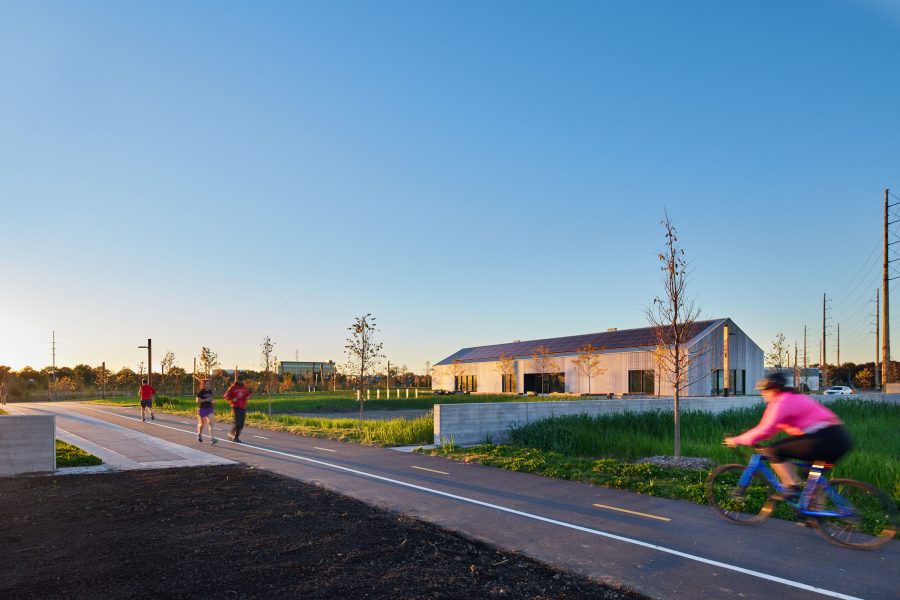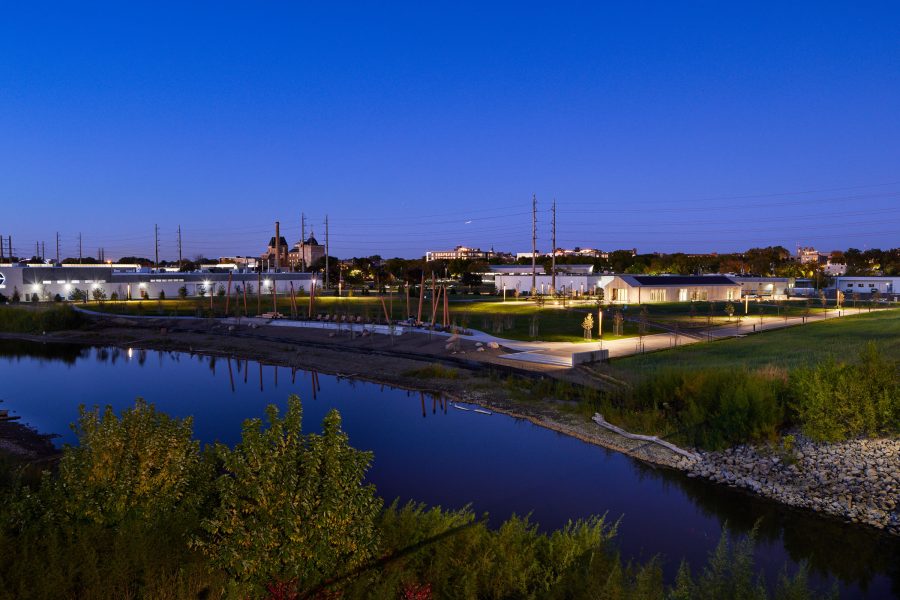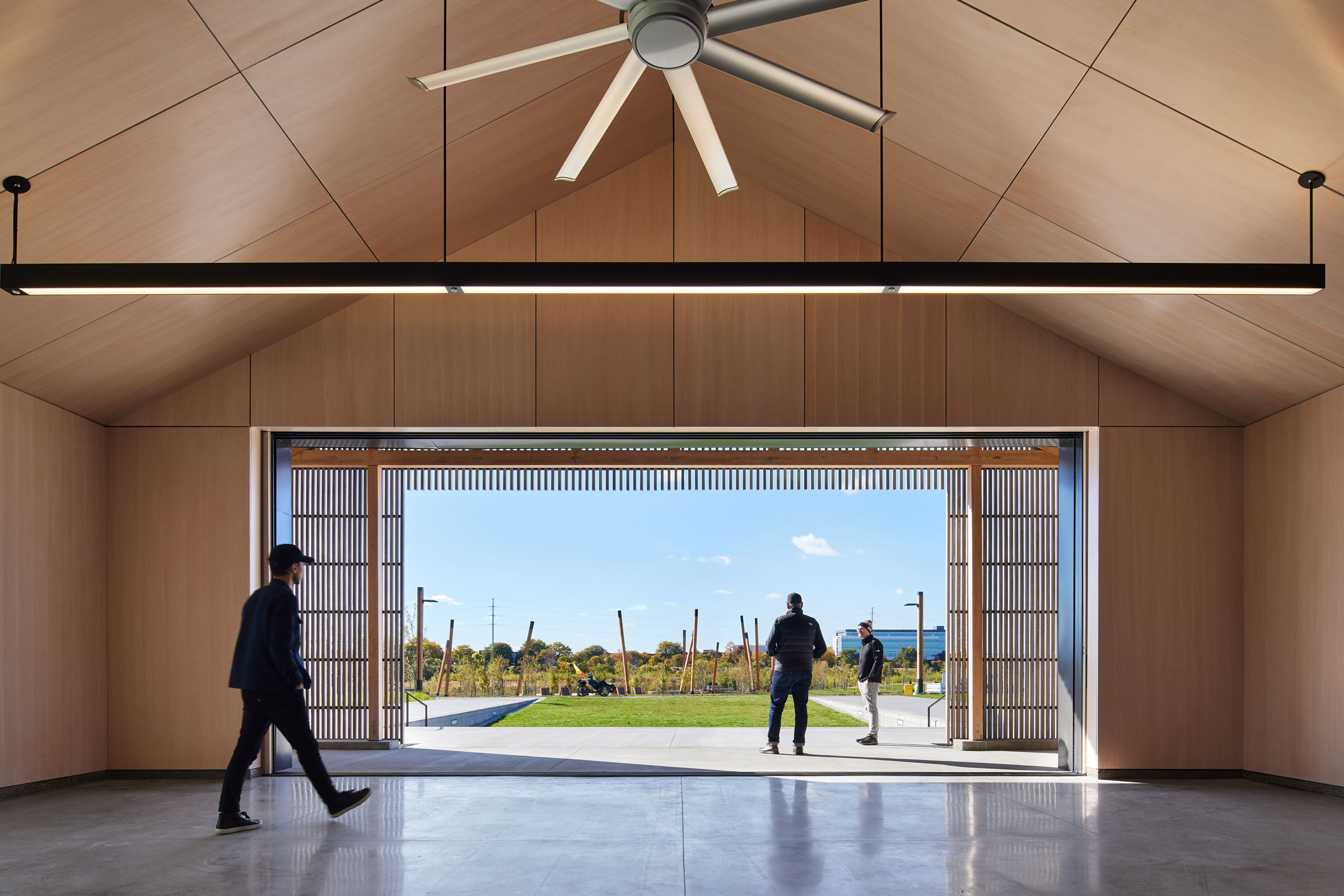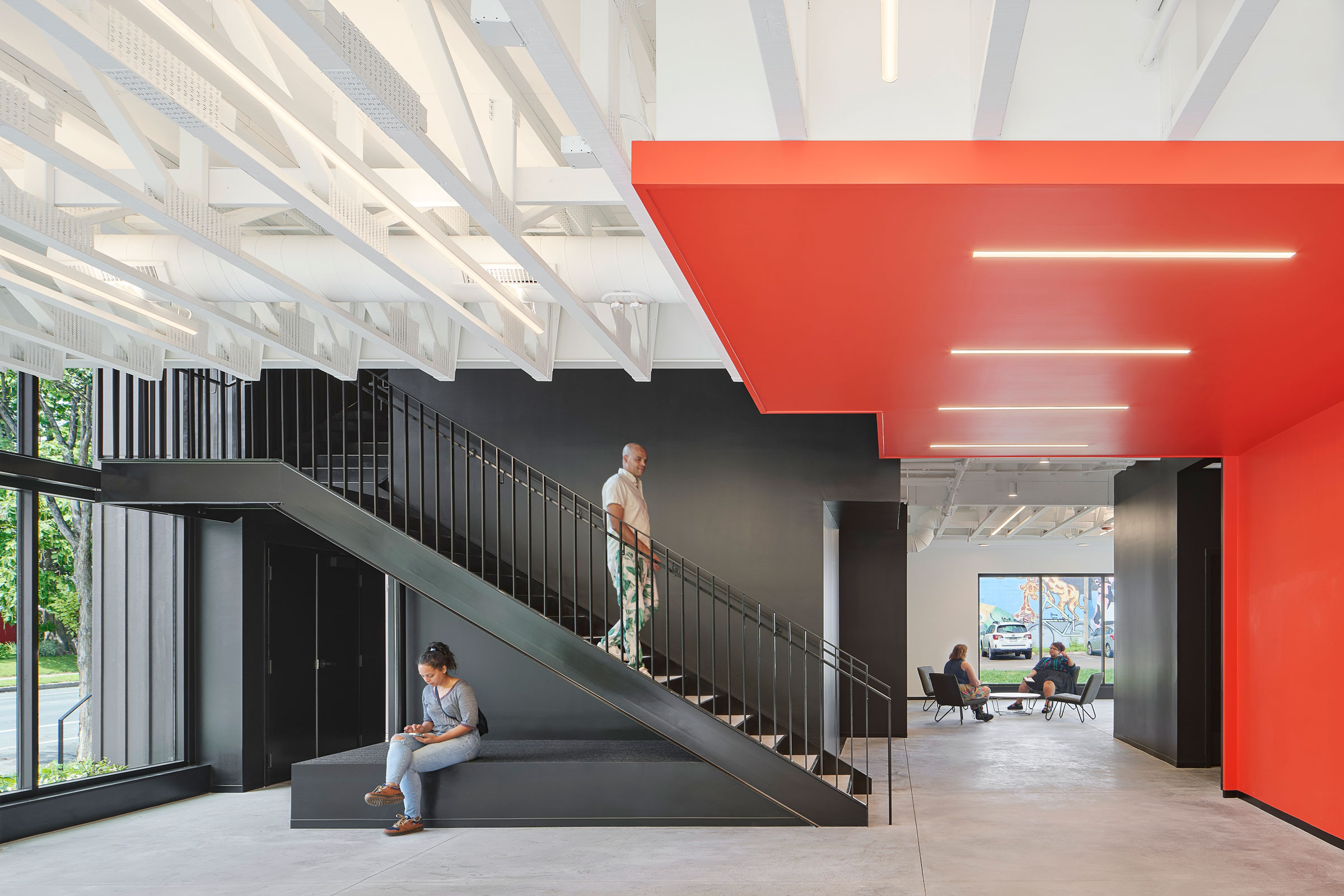Story at a glance:
- A net zero multipurpose building near the Mississippi River recalls the area’s past while building for the future.
- Designed by Snow Kreilich Architects, the multipurpose building invites more of the local community to experience Graco Park.
- The park’s landscape layout emphasizes habitat restoration and ecological connectivity. Landscape space defines the park, including a tree-lined promenade, river walk, ecological bee lawn green, regional trail, and performance space.
Preserving and celebrating habitat and history were major goals of the Graco Park project—including the new River Hub building and the newly developed landscape surrounding it.
Materials & Construction

Photo by Corey Gaffer Photography, courtesy of Snow Kreilich Architects
Aside from its foundation, the building is wood from top to bottom, says Doug Gerlach, associate principal and design director at Snow Kreilich Architects. “The story of this project from a material standpoint is all about the wood,” he says.
“That goes back to the sawmilling history of the site. The form of the building itself is this kind of simple shed form, referencing that history.”
Both heavy timber and light wood framing dominate the project. Double-wythe stud walls use conventional wood framing to provide more space for insulation and a thermal break between wythes. Panelized detailing and advanced framing techniques bolster economy and thermal performance, respectively, according to the firm. The double-wythe stud walls and wood trusses are infilled with economic, moisture-tolerant, and low-embodied carbon dense pack cellulose insulation.
Inside, the space is lined with birch plywood finishes, providing material warmth, durability, and low embodied carbon use. The exterior rainscreen is a thermally modified ash wood.
“The building is highly modular. It’s based on a 24-inch and a 4-foot module that allows both framing and panel materials like plywood to be installed in a really efficient manner that reduces the amount of wasted material in the fabrication,” Gerlach says. “The whole thing is designed around this module that both helps with material waste and also speaks to the industrial regularity of the site’s past.”
The site’s history also inspired the firm to consider a more residential construction strategy in terms of wall assembly and to make a super insulated wall. “We had it priced out with our cost estimating partners: Do we do a commercial type of wall where you have metal studs with continuous exterior insulation or a passive house strategy with a double stud wall cavity with dense packed cellulose? That was both looking at potential cost savings but also thinking about, for smaller scale contractors, what would be more approachable and more comfortable to build?”
The approach essentially “supersized” common construction techniques, Gerlach says, and helped the team to achieve net zero, something that wasn’t necessarily a goal at the beginning. “We were able to do a lower-carbon project just by using conventional wood stud construction instead of metal stud frame for the building,” says Mary Springer, project manager on the project and an associate principal at Snow Kreilich Architects.
The project also uses a bird-friendly, triple-pane, low-E glass with a visible applied pattern for bird safety. “We didn’t choose to use the invisible ones, both for cost and also because we’re telling the story of this place in the architecture. It being apparent that it’s bird-safe glass supports the project as a whole,” Springer says.
The Call for Net Zero

The building’s envelope features a wood scrim facade that continues over floor-to-ceiling windows, enhancing its aesthetic appeal while serving as a passive solar shading device to minimize heat gain in summer. Photo by Corey Gaffer Photography, courtesy of Snow Kreilich Architects

Two broad, tree-lined promenades, a river walk, a flexible green, and a building/plaza zone define Graco Park, where Snow Kreilich Architects designed a new building. Photo by Corey Gaffer Photography, courtesy of Snow Kreilich Architects
Gerlach says that while the building industry faces a learning curve around net-zero, high-performance construction, expectation-setting and education at the beginning and throughout a project pays off.
“It wasn’t initially part of the project to do a net zero or sustainable project in any defined sense,” Gerlach says. The idea arose after the community engagement process. “What kept coming up over and over was habitat and the importance of the site being along the Mississippi River flyway for migratory birds. It changed the way the park board thought about the park program. Then, as we were seeing this environmental focus for the park itself, it started to make a lot of sense to think about the building as having a harmonious relationship with the natural environment.”
The firm pitched net zero to the park board. It would be the first such building in their vast portfolio of projects. “We said, ‘We think this would make a lot of sense. We think it will add cost, but we want to put it in front of you and see if it’s something you’d be interested in doing.’ It was something that really resonated with their mission,” Gerlach says.
Springer says the park board, widely celebrated as one of the top park systems in the country year after year, wanted to walk the talk. “They knew that it would be impactful in terms of their energy footprint for the project.”
Connecting Community

Photo by Corey Gaffer Photography, courtesy of Snow Kreilich Architects
The riverfront site sits near Hall’s Island. “At one time that island and the riverbank were all subsumed into a single land mass that was used for sawmilling. It was very detrimental to the ecological function that the island was providing,” Gerlach says.
Phase one of the Graco Park project involved the park board dredging out the site to reconstitute the island and restore its ecological function. The scope included restored vegetation on the island and reef infrastructure in the channel to support native mussel habitat.
Phase two built upon those habitat restoration efforts and strengthened ties to the community with a multipurpose building that accommodates various publicly connected initiatives and an accessible park that connects to the riverfront. “It’s a really cool story that’s taken place over 20 years,” Gerlach says.
Initial discussion about phase one included potentially having a bridge to bring people over to Hall’s Island. “Ultimately the decision was made to preserve that island for habitat, that the best thing we could do was to not allow humans to go over there at all,” Springer says.
Graco Park is part of a larger mission of the park board to create a public green corridor along the river, and this phase connects the bikeway along the river frontage, Springer says. It also starts to bring some of the more disconnected areas back in. Gerlach points to the Grand Rounds National Scenic Byway, where you can go around the entire city essentially on parkway. “It’s a really great experience, but what happens is when you get to a certain part of north and northeast, it starts getting choppy and disconnected. This initiative is about trying to stitch that together and create a more equitable balance of green space in the city. It’s been in the works for a couple decades, but the experience of the city changes a little bit with the new project.”
Social equity is a big part of the sustainability story of Minneapolis, Gerlach says. “Being in the city where George Floyd was murdered, it had a huge impact on our city, the culture, and really stimulated a lot of discussion around issues of equity. This project is part of the park board putting those ideas and that thought process in built form.”
The building includes a tech maker space for neighborhood youth to learn everything from 3D printing to podcasting. “That represents an investment both in environmental sustainability but also a kind of social sustainability in part of the city,” Gerlach says. “This building kind of straddles the northeast neighborhood, downtown, and the north neighborhood. North and northeast have fewer parks than some of the other neighborhoods in the city and fewer amenities and opportunities. This is a great investment in those neighborhoods.”
Springer says the firm in general is seeing a trend toward more sustainable architecture across the Twin Cities. The city also introduced a very progressive zoning code as part of its Minneapolis 2040 plan, including incentives for developers to build sustainably and incentivize more density in the residential neighborhoods. And the park board continues to play an important role. “They persisted, and they’re making this vision closer and closer to reality.”



